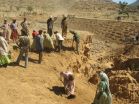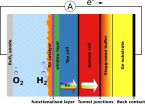(Press-News.org) BERKELEY -- A new study by University of California, Berkeley, researchers establishes for the first time a link between infection with the bovine leukemia virus and human breast cancer.
In the study, published this month in the journal PLOS ONE and available online, researchers analyzed breast tissue from 239 women, comparing samples from women who had breast cancer with women who had no history of the disease for the presence of bovine leukemia virus (BLV). They found that 59 percent of breast cancer samples had evidence of exposure to BLV, as determined by the presence of viral DNA. By contrast, 29 percent of the tissue samples from women who never had breast cancer showed exposure to BLV.
"The association between BLV infection and breast cancer was surprising to many previous reviewers of the study, but it's important to note that our results do not prove that the virus causes cancer," said study lead author Gertrude Buehring, a professor of virology in the Division of Infectious Diseases and Vaccinology at UC Berkeley's School of Public Health. "However, this is the most important first step. We still need to confirm that the infection with the virus happened before, not after, breast cancer developed, and if so, how."
Bovine leukemia virus infects dairy and beef cattle's blood cells and mammary tissue. The retrovirus is easily transmitted among cattle primarily through infected blood and milk, but it only causes disease in fewer than 5 percent of infected animals.
A 2007 U.S. Department of Agriculture survey of bulk milk tanks found that 100 percent of dairy operations with large herds of 500 or more cows tested positive for BLV antibodies. This may not be surprising since milk from one infected cow is mixed in with others. Even dairy operations with small herds of fewer than 100 cows tested positive for BLV 83 percent of the time.
What had been unclear until recently is whether the virus could be found in humans, something that was confirmed in a study led by Buehring and published last year in Emerging Infectious Diseases. That paper overturned a long-held belief that the virus could not be transmitted to humans.
"Studies done in the 1970s failed to detect evidence of human infection with BLV," said Buehring. "The tests we have now are more sensitive, but it was still hard to overturn the established dogma that BLV was not transmissible to humans. As a result, there has been little incentive for the cattle industry to set up procedures to contain the spread of the virus."
The new paper takes the earlier findings a step further by showing a higher likelihood of the presence of BLV in breast cancer tissue. When the data was analyzed statistically, the odds of having breast cancer if BLV were present was 3.1 times greater than if BLV was absent.
"This odds ratio is higher than any of the frequently publicized risk factors for breast cancer, such as obesity, alcohol consumption and use of post-menopausal hormones," said Buehring.
There is precedence for viral origins of cancer. Hepatitis B virus is known to cause liver cancer, and the human papillomavirus can lead to cervical and anal cancers. Notably, vaccines have been developed for both those viruses and are routinely used to prevent the cancers associated with them.
"If BLV were proven to be a cause of breast cancer, it could change the way we currently look at breast cancer control," said Buehring. "It could shift the emphasis to prevention of breast cancer, rather than trying to cure or control it after it has already occurred."
Buehring emphasized that this study does not identify how the virus infected the breast tissue samples in their study. The virus could have come through the consumption of unpasteurized milk or undercooked meat, or it could have been transmitted by other humans.
INFORMATION:
The University of California Breast Cancer Research Program and the U.S. Department of Defense Breast Cancer Research Program helped support this research.
Planning conservation actions requires up-to-date information on
Biodiversity is diminishing at unprecedented rates, and quick decisions are needed in what and where to protect.
"The decisions should be based on comprehensive information, but scientists do not have enough resources to collect more data and effectively monitor all species and habitats that need protection. As human are the main driving force of global change, conservation also needs information on human presence and behaviour" says Enrico Di Minin, a researcher in conservation science at the Department ...
A new study has found increasing support in the United States and Canada for smokefree laws for outdoor areas, especially in playgrounds and school grounds.
The collaborative study between the University of Otago, New Zealand and University of Alberta, Canada, provides new and some unexpected insights for health promotion in North America. A key finding is that most residents welcome smokefree laws. Support was strongest for smokefree playgrounds and school grounds, but there was also majority support for a range of other smokefree areas.
University of Otago, Wellington ...
Highly diluted acetic acid, an active ingredient of household vinegar, has been shown to be an effective alternative agent to prevent infection and kill bacteria found in burn wounds.
Researchers from the University of Birmingham and the National Institute for Health Research (NIHR) Surgical Reconstruction and Microbiology Research Centre (SRMRC) investigated the antibacterial activity of acetic acid against key burn wound colonising organisms growing both planktonically and as biofilms.
Burns are a common traumatic injury and prone to becoming infected due to loss ...
On Sept. 13, 2015, as NASA's Solar Dynamics Observatory, or SDO, kept up its constant watch on the sun, its view was photobombed not once, but twice. Just as the moon came into SDO's field of view on a path to cross the sun, Earth entered the picture, blocking SDO's view completely. When SDO's view of the sun emerged from Earth's shadow, the moon was just completing its journey across the sun's face.
Though SDO sees dozens of Earth eclipses and several lunar transits each year, this is the first time ever that the two have coincided. This alignment of the sun, moon and ...
New research from the University of Washington's Friday Harbor Laboratories shows that a more acidic ocean can weaken the protective shell of a delicate alga. The findings, published Sept. 9 in the journal Biology Letters, come at a time when global climate change may increase ocean acidification.
The creature in question is Acetabularia acetabulum, commonly called the mermaid's wineglass. Reaching a height of just a few inches, this single-celled alga lives on shallow seafloors, where sunlight can still filter down for photosynthesis. Like many marine creatures, the ...
UC San Francisco has received a National Cancer Institute grant of $5 million over the next five years to lead a massive effort to integrate the data from all experimental models across all types of cancer. The web-based repository is an important step in moving the fight against cancer toward precision medicine.
The goal is to accelerate cancer research to improve the way we diagnose, treat and conduct further research on the disease. The resulting database, called the Oncology Models Forum (OMF), will be accessible to researchers through the National Institutes of ...
Current drugs may stop working against the most common type of brain tumor in children, medulloblastoma, but the tumor could be targeted in a new way, according to Stanford University scientists.
In research to be published in the journal eLife, a team led by Prof. Matthew P. Scott at the University's School of Medicine tested a drug called Roflumilast in mice with a brain tumor that is resistant to Vismodegib, the drug in current use. Roflumilast is normally used to treat inflammatory lung diseases. It dramatically inhibited tumor growth from the first day of treatment. ...
This news release is available in French.
Montreal, September 15th 2015 - It is estimated that half of all cancer patients suffer from a muscle wasting syndrome called cachexia. Cancer cachexia impairs quality of life and response to therapy, which increases morbidity and mortality of cancer patients. Currently, there is no approved treatment for muscle wasting but a new study from the Research Institute of the McGill University Health Centre (RI-MUHC) and University of Alberta could be a game changer for patients, improving both quality of life and longevity. The ...
To better inform the tradeoffs involved in land use choices around the world, experts have assessed the value of ecosystem services provided by land resources such as food, poverty reduction, clean water, climate and disease regulation and nutrients cycling.
Their report today estimates the value of ecosystem services worldwide forfeited due to land degradation at a staggering US $6.3 trillion to $10.6 trillion annually, or the equivalent of 10-17% of global GDP.
Furthermore, the problem threatens to force the migration of millions of people from affected areas. ...
Solar energy is abundantly available globally, but unfortunately not constantly and not everywhere. One especially interesting solution for storing this energy is artificial photosynthesis. This is what every leaf can do, namely converting sunlight to chemical energy. That can take place with artificial systems based on semiconductors as well. These use the electrical power that sunlight creates in individual semiconductor components to split water into oxygen and hydrogen. Hydrogen possesses very high energy density, can be employed in many ways and could replace fossil ...




